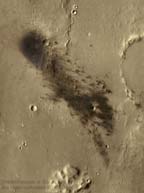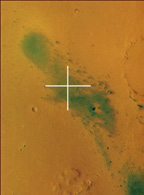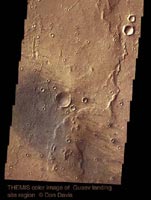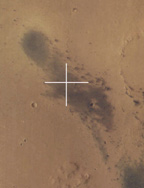
| Bad Astronomy |
|
|
|
BA Blog
|
|
Q & BA
|
|
Bulletin Board
|
| Media |
|
|
|
Bitesize Astronomy
|
|
Bad Astro Store
|
|
Mad Science
|
|
Fun Stuff
|
| Site Info |
|
|
|
Links
|
| RELATED SITES |
| - Universe Today |
| - APOD |
| - The Nine Planets |
| - Mystery Investigators |
| - Slacker Astronomy |
| - Skepticality |
Buy My Stuff

Keep Bad Astronomy close to your heart, and help make me
filthy rich. Hey, it's either this or one of those really
irritating PayPal donation buttons here.
The Not-Always-Red Planet
Does Mars Have Vast Green Areas?
The quick answer to this is: no.
The longer answer is somewhat more involved.
On Hoagland's website, he has a side-by-side comparison of two images. One image shows a close-up of Gusev crater as taken by the Mars Odyssey probe. The second image is of the same region, but taken by the European Space Agency (ESA) Mars Express probe. I have reproduced them below. The difference between them is obvious; the image on the left shows a large greyish area, where the image on the right shows it as a vivid green (the crosshair in the Mars Express image is in the original image).
 |
 |
On his website, Hoagland has this to say about these images (and I quote, both words and capitalization):
|
Spirit Gusev Landing Site From NASA and ESA Images. Is THIS why NASA is Lying About the True Colors of Mars? |
He then labels the image on the left "NASA (Odyssey -- colorized)" and the one on the right "ESA (Mars Express -- HRSC Color)".
Hoagland's label for the left image is incorrect: while it uses NASA data, it was actually created by renowned space artist Don Davis. Davis did this on his own time, and is not a NASA employee. Hoagland saying it's from NASA is maybe not exactly lying, but it is at least intellectually dishonest. Since the image does not appear anywhere on a NASA site, Hoagland must know it is not a NASA image. The images I have displayed on this page are used with the permission of Don Davis.
By putting these images side-by-side, and writing what he did, Hoagland is strongly implying that NASA is changing the colors on their images to downplay the green color. In other words, he is implying the ESA Mars Express image is correctly colored, and the Odyssey image is not. In fact, by saying it was colorized, that makes it sound like NASA did some nefarious changes to make it look less like there is life on Mars.
Knowing that there was more here than meets the eye, I did something few pseudoscientists ever do: I sent out email to some experts to get more information. Davis emailed me back immediately, and told me what's going on.
The Odyssey image, taken by a camera called THEMIS, is indeed colorized. However, it's not what Hoagland implies. It's actually a greyscale image, what most people (erroneously) call "black and white". The digital camera on the spacecraft does not see in color like our eyes do; it can only tell the difference between how bright regions are, and then translates that brightness into a pixel intensity. If you want to make a color image from this, you need to take images through different filters, then add the images together. In practice, this is pretty hard because getting the color balance right is painstaking work, and loaded with pitfalls.
So Davis didn't try to make a color picture, at first. The image shown, the one Hoagland uses, is not, nor was it meant to be, "true color". Instead, Davis took red, green, and blue values given to him by an outside source and used them as a guide to tinting the greyscale image. So not only is this not supposed to be true color, it was in fact colorized by hand!
As it happens, Davis was unsatisfied with the way the image looked. Eventually, he took the THEMIS images from other filters and used them to create a better representation of the real color of the surface. That image is displayed below, side-by-side with the first one (the image on the right shows a smaller area of the surface of Mars; it covers a portion of the upper-left-hand side of the first image).
 |
 |
Note that the colors have changed subtly, and the contrast between the dark and light areas is lower. The first image was meant to be preliminary, one step on the way top making truer images, and was never meant to be seen by the public. Davis never stated it was meant to be real color, either, despite what pseudoscientists are saying. However, Hoagland took it and displayed it, so once the cat was out of the bag, it was too late.
So much for the colorized image. But what about the GREEN one?
Like THEMIS, the Mars Express camera (called the High Resolution Stereo Camera) also takes multi-filter images. It is possible to take these separate images and construct a three-color image from them using, say, Photoshop. But remember, this is actually a very difficult process to get right. It takes a lot of tweaking. I have done this myself using Hubble images, and it can take days to get it right.
The green Mars Express image was not properly color calibrated. The color image was made for a press release, and in general, a spaceprobe imaging team doesn't have much time to put together a pretty image for the press. So they usually hastily assemble something that may not have the colors done perfectly (I have seen this happen more than once). Suspecting this was the case for the Mars Express image, I emailed the Principal Investigator for the camera, Dr. Gerhard Neukum. He kindly replied, telling me this is exactly what happened. [Note added March 12, 2004: in fact, the ESA has corrected the original image so it is no longer green. The new image can be found here.]
In fact, both Don Davis and Dr. Neukum told me that the rocks in the images are basaltic, which are known to be dark grey, or bluish black (the basaltic content was determined using mineralogical image maps made of Mars by spacecraft). This indicates immediately the green color is not correct. In fact, Dr. Neukum told me that the imaging team wants to reprocess the data, but it takes time, and they have a lot of scientific data to go through!
So Davis decided to give it a try on his own. He took the raw images from the Mars Express, and assembled them with care to get the color balance right. Below I display the results, with the first Odyssey image (the same as above) on the left, the green Mars Express image in the middle, and the new Mars Express image on the right. Note that by using the very same data from the "green" image, we can see the image shouldn't be green at all. This clinches the idea that the press release version has the wrong color balance. As you'd expect, the image still does not match the colors of the Odyssey image, because the Odyssey image was colorized using a greyscale image.
 |
 |
 |
So ironically, the three-color image is not "true color", because the color balance is off, and the single color image which was colorized by an artist more closely resembles the real colors of Mars.
Had Hoagland actually bothered to ask someone involved with the projects, he would have found the truth. But, like most pseudoscientists, it's only his version of the truth he wants you to see.
|
|
|
|